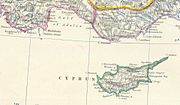The battle of Cape Celidonia took place on 14 July 1616 during the Ottoman-Habsburg struggle for the control of the Mediterranean when a small Spanish fleet under the command of Francisco de Rivera y Medina cruising off Cyprus was attacked by an Ottoman fleet that vastly outnumbered and outgunned it. Despite this, the Spanish ships, mostly galleons, managed to repel the Ottomans, whose fleet consisted mainly of galleys, inflicting them heavy losses.
Background

Area of Rivera's cruise.
In mid-1616 a Spanish fleet under the command of Captain Don Francisco de Rivera y Medina sailed from the Spanish Kingdom of Sicily to the Eastern Mediterranean waters in order to privateering against Ottoman vessels and ports in the area between Cyprus and the region of Çukurova. It was composed by 5 galleons and a patache. These ships were the 52-gun Concepción, flagship of Rivera; the 34-gun Almirante, commanded by alférez Serrano; the 27-gun Buenaventura, under Don Ínigo de Urquiza; the 34-gun Carretina, commanded by Balmaseda; the 30-gun San Juan Bautista, commanded by Juan Cereceda; and the 14-gun patache Santiago under Gazarra. Aboard the ships were about 1,600 Spanish soldiers, of whom 1,000 were musketeers.[1]
The Spanish fleet sailed to the island of Cyprus, then under Ottoman rule, where Francisco de Rivera ordered sight land prior to begin the cruise. During this one 16 merchant caramoussals were captured by Rivera's fleet off Cape Celidonia, as well as an English privateer in Famagusta and a large number of minor vessels in the sea.[5] In addition 10 warships were sunk or burnt in the port of Salinas, whose defenses were also destroyed by a landing party which suffered no loss.[5] The Ottoman governor of Cyprus, who was rapidly informed of the Spanish activities, called for help to the Ottoman navy. Rivera, warned of it thanks to the capture of a merchant vessel coming from Constantinople, decided to wait for his pursuers off Cape Celidonia to return to Sicily having won a great victory.[5] A Turkish fleet of 55 galleys with about 275 guns and 12,000 fighting men on board appeared off the cape few days later, on 14 July.[1]
Battle
The battle began at 9 am when the Ottoman galleys moved toward the Spanish ships and opened fire over them. Previously they had formed a huge crescent, to encircle the Spanish ships. To avoid ships becoming separated and being overwhelmed individually in the light conditions, de Rivera ordered his ships join each other end to end with chains. The Concepción stood at the vanguard, being followed by the Carretina, the Almiranta, and the patache Santiago.[6] The other two ships remained on standby. Their heavy artillery fire kept off the Turkish vessels until the sunset. Then the attackers withdrew to their initial positions with eight galleys about to sink and many damaged.[6]
The attack was resumed the next morning, when, after a night war council, the Ottomans attacked divided into two groups, each of whom tried to capture the Capitana (or flagship) and the Amiranta (or secondary ship) respectively. They approached enough to be within the range of the Spanish muskets, but this meant that the galleys were subjected to the heavy gunfire of all the Spanish ships. Unable to board the Spanish ships, they withdrew in the evening with another 10 galleys heeling over.[6]
That night took place a new council of war aboard the Turkish fleet during which it was decided to resume the action at dawn. Then, after a speech that boosted their morale, the Ottomans attacked with great drive and managed to move under Rivera's flagship to exploit her blind spot. But the Spanish commander, who had foreseen such a possibility, ordered the Santiago move to his ship's bow. This maneuver exposed the Turkish galleys to a heavy gunfire which inflicted them severe damage, being finally forced to withdraw at 3:00 pm with a galley sunk, two dismasted and 17 others severely damaged or heeling over.[7]
Aftermath
The Turkish fleet suffered heavy losses, with 10 galleys sunk and another 23 disabled. 1,200 Janissaries and 2,000 sailors and rowers were killed.[4] The Spanish, suffered 34 dead and 93 wounded and damage to the rigging of the Concepción and the Santiago, which had to be towed by the other ships. For his success Rivera was promoted to Admiral by King Philip III, who also rewarded him with the habit of the Order of Santiago.[4] The soldiers and sailors of the fleet were also recognized by the Duke of Osuna. Some time later the Spanish playwright and poet Don Luís Vélez de Guevara wrote the comedy "El asombro de Turquía y valiente toledano"(the wonder of Turkey and corageous toledan) to commemorate the battle.[7]
Notes
References
- (Spanish) Fernández Duro, Cesáreo (2006). El gran duque de Osuna y su marina: jornadas contra turcos y venecianos (1602–1624). Spain: Editorial Renacimiento. ISBN 978-84-8472-126-0.
- (Spanish) Rodríguez González, Agustín Ramón (2004). Lepanto, la batalla que salvó a Europa. Spain: Grafite Ediciones. ISBN 978-84-96281-16-5.
- (Spanish) Linde, Luís M. (2005). Don Pedro Girón, duque de Osuna: la hegemonía española en Europa a comienzos del siglo XVII. Madrid, Spain: Encuentro. ISBN 978-84-7490-762-9.
| ||||||||||||||||||||||||||||||||||||||||||
The original article can be found at Battle of Cape Celidonia and the edit history here.